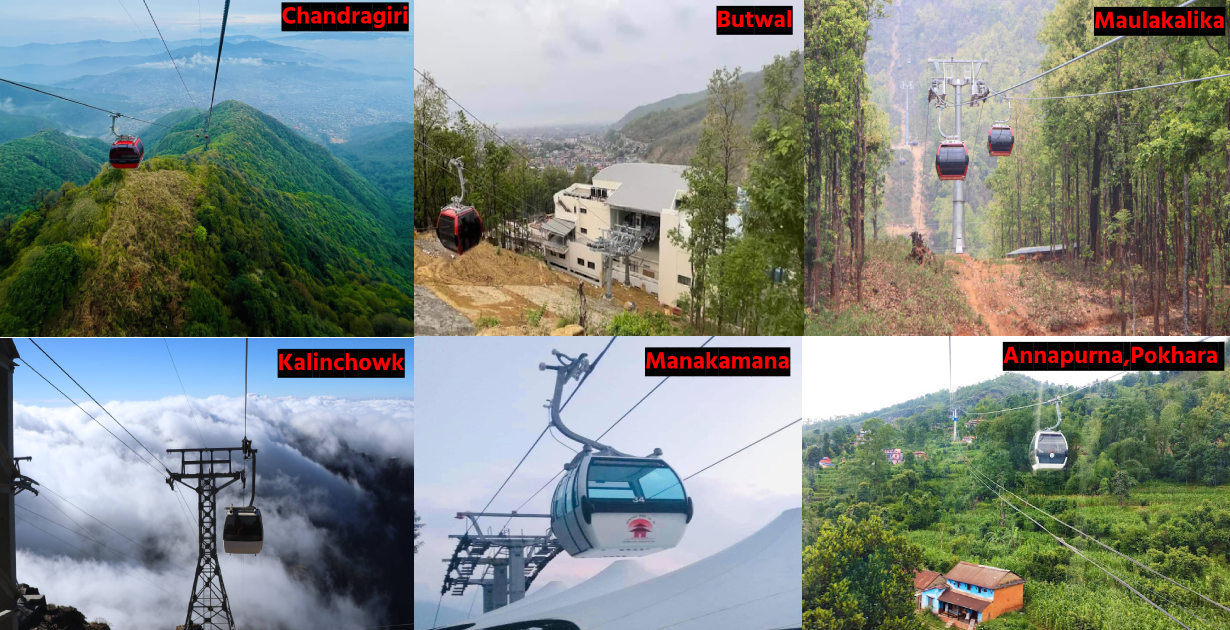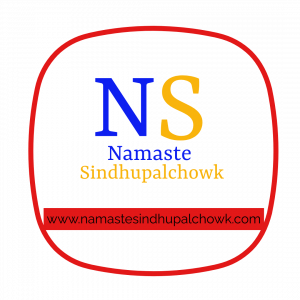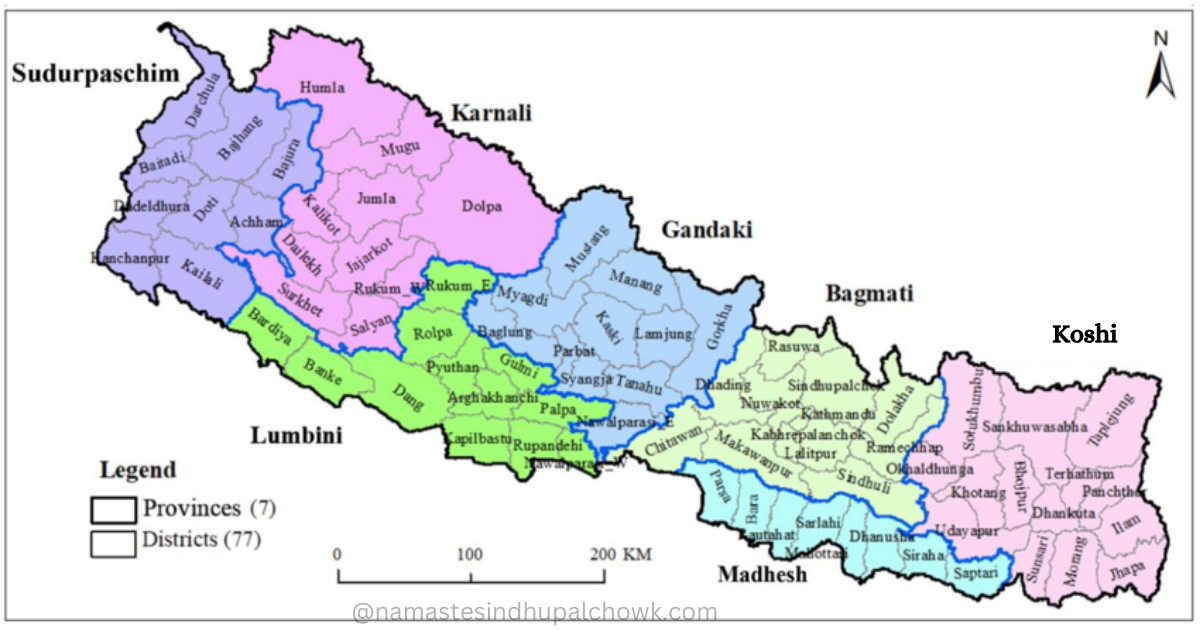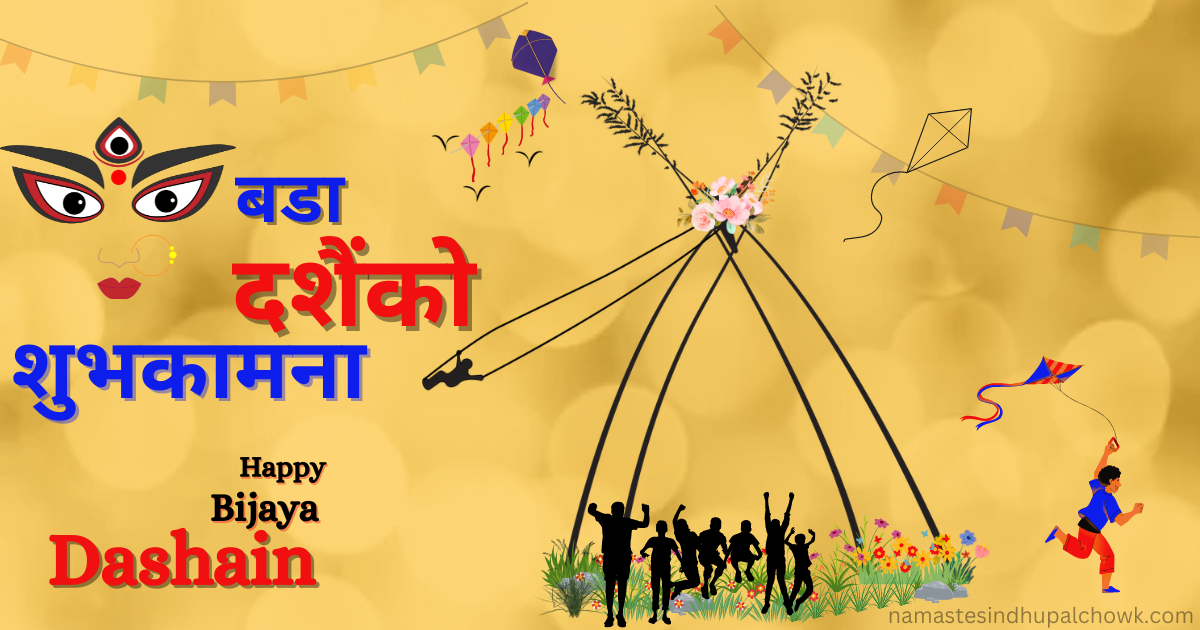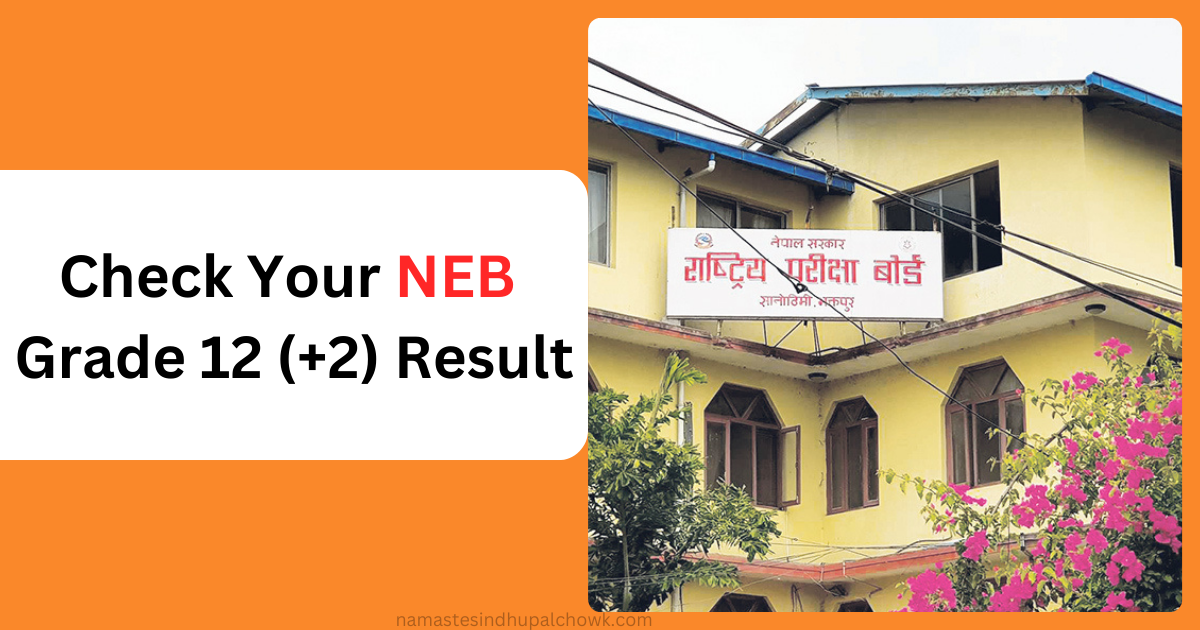Nepal is a country with beautiful mountains and hills. It has become a top destination for the world tourism industry. Recently, cable cars have gained popularity as a means of transportation in Nepal's tourism sector. Cable cars have become a major attraction for both domestic and international tourists. Moreover, new tourist destinations have been developed in hilly areas. And, various private companies in Nepal are eagerly constructing cable cars, luxurious resorts, children's parks, and religious sites in these regions.
The cable car is the improved version of ropeways. During Chandra Shamsher's time in Nepal, they constructed a ropeway from Hetauda to Kathmandu to transport industrial materials. The first cable car in Nepal connects Kurinatar in Chitwan to the famous Mankamana temple in Gorkha.
Currently, there are six fully operational cable cars in Nepal, located at different sites. These cable cars have enhanced the allure of Nepal's hill stations for both domestic and international tourists. They have also brought significant changes to the country's tourism industry. Let's delve into the captivating history of cable cars in Nepal, learn about their operational routes, and highlight their importance and impact on the country's development.
Cable Car History in Nepal
The use of Cable cars started in the mid-19th century. At that time, people mostly used Cable cars (Ropeway) for transportation in mining areas. As time passed, cable cars turned into famous tourist attractions. By using the cable car people enjoy breathtaking views of the natural hills, Jungles, & mountains. Nowadays, cable cars have played a vital role in Nepal's tourism industry. Because It has helped to provide tourists with a remarkable and easy way to reach the country's revered destinations.
1. Ropeway Era in Nepal
When examining the background of cable car development in Nepal, we can consider the Kathmandu-Hetauda ropeway constructed in 1922 as a starting point. Back then, the ropeway was used for transporting industrial materials. However, the current cable car has now become a popular means of transportation for tourists. Ropeways are utilized in various mines established in Nepal. In the Sindhupalchok district, a ropeway was constructed in 2035 to transport raw materials for the magnesite industry located in Lamosanghu. Moreover, This ropeway connected the magnesite industry in Lamasanghu, Sindhupalchok, with the mine in Kharidhunga, Dolakha. Above we have seen about the ropeway operating in Nepal. Now let's look at the background of the cable car, which has become a tourist attraction in Nepal.
2. Cable car Era in Nepal
The first cable car in Nepal is the 2.8 km long cable car that connects Kurinatar in Chitwan to Mankamana in Gorkha. Travellers wanted a simple and cheap way to visit Manakamana, a famous Hindu religious site. At that time, Manakamana Darshan Private Limited built the Manakamana cable car in 2055. Travellers and devotees were attracted to it because they could reach Manakamana Darshan safely, easily, and inexpensively. This cable car is special because it allows you to reach Mankamana quickly while enjoying the scenery of beautiful mountains, village houses, farm fields, and local products.
Afterwards, it took approximately 17 years for Nepal to have another cable car. In 2073, the IME Group constructed and began operating a cable car that connects Thankot in Kathmandu to Chandragiri Hill. And, This cable car is the second one in Nepal. Currently, several cable cars are being built in hill stations across Nepal. Furthermore, Some examples of these recently operating cable cars in Nepal include Sarankot, Kalinchok, Lumbini, and Maulakalika.
Cable car Routes in Nepal
Nepal currently has six operational cable car routes. In those areas, cable car operators have already begun constructing various resorts, hotels, and fun parks. The fully operational cable cars in Nepal include Manakamana, Chandragiri, Kalinchok, Pokhara, Lumbini, and Maulakalika. Additionally, cable cars such as Bandipur, Siddharth, Champadevi, Pathibhara, and Pokhara - Muktinath are either under construction or being planned in Nepal. Now, let's delve into the details of the cable car routes in Nepal.
| Cable Car | Places | Length | Total Investment (with Resorts) |
|---|---|---|---|
| Manakamana | Kurintar - Manakamana | 2.8 KM | 1.58 Arab |
| Chandragiri | Thangkot - Chandragiri | 2.4 KM | 3 Arab |
| Annapurna | Fewatal - Sarangkot | 2.4 KM | 2 Arab |
| Kalinchowk | Kuri - Kalinchowk | 0.9 KM | 45 Crore |
| Maulakalika | Gaidakot - Maulakalika | 1.2 KM | 2 Arab |
| Lumbini | Butwal - Palpa - Basantapur | 2.6 KM | 5 Arab |
1. Manakamana Cable Car
The Mankamana Cable Car is Nepal's first cable car. It started operating on November 24, 1998. There was a large crowd of devotees at the famous Mankamana temple in Gorkha. Meanwhile, Laxman Babu Shrestha came up with a plan to connect Manakamana to the East-West Highway. Then, He established Manakamana Darshan Pvt Ltd to run a cable car from Kurintar in Chitwan to Manakamana. Moreover, This cable car has made it easy, affordable, fast, and reliable to reach Mankamana, attracting more devotees. The cable car spans a length of 2.8 km. Manakamana Darshan operates this cable car. additionally, The renowned Doppelmayr Group, known for its efficient and high-performing ropeway technology, was responsible for installing this advanced system. With this top-notch infrastructure, Manakamana Darshan serves over a million pilgrims annually, providing them with an extraordinary travel experience.
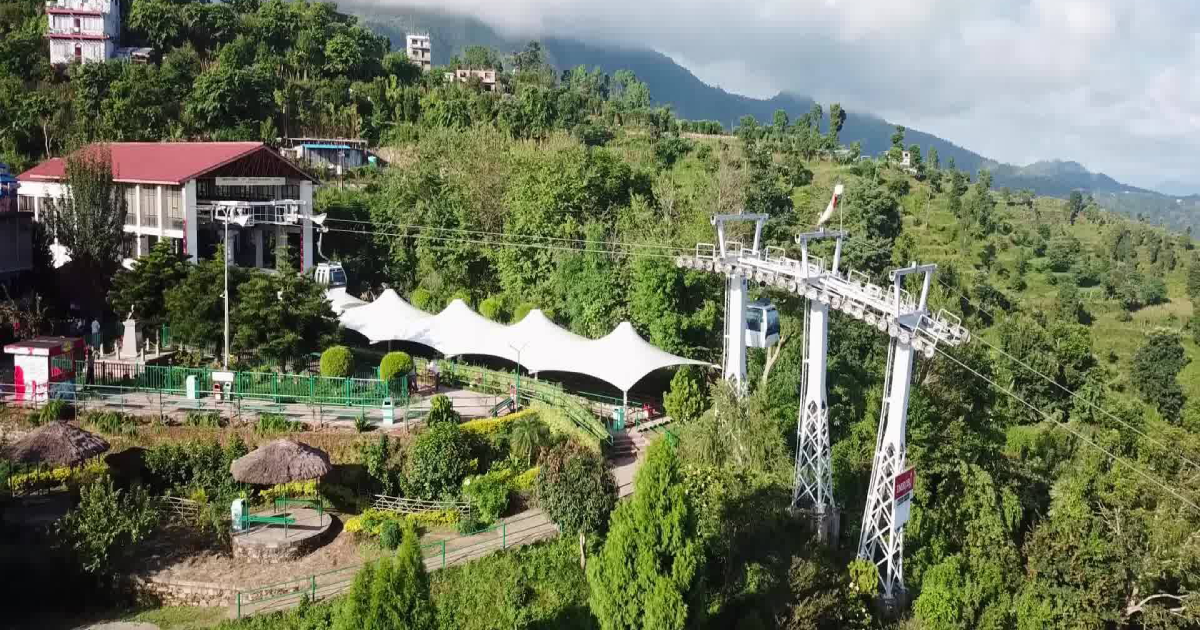
Kurintar is the starting point of the Manakamana cable car. And, it is about 110 km west of Kathmandu. During the journey of this cable car, one can taste the beautiful villages, mountains, forests, local products etc. Furthermore, the price of this cable car varies, according to age group, nationality etc. As we all know, Manakamana is a famous temple of Bhagwati. It is believed that every wish will be fulfilled by visiting here.
Tickets Rate of Manakamana Cable Car
| Tickets Types | One Way | Two Way |
|---|---|---|
| Nepali | Rs. 450 | Rs. 770 |
| Child | Rs. 270 | Rs. 460 |
| Student | Rs. 335 | Rs. 575 |
| Senior Citizen | Rs. 315 | Rs. 540 |
| Differently Abled | Rs. 225 | INR. 670 |
| Indian Adult | INR. 400 | Rs. 880 |
| Indian Child | INR. 240 | INR. 400 |
| SAARC/ Chinese | $ 6 | $ 10 |
| SAARC/ Chinese Child | $ 4 | $ 7 |
| Foreigner | $ 11 | $ 20 |
| Child Foreigner | $ 8 | $ 15 |
| Goat | Rs. 275 | |
| Goods Per Kg | Rs. 17 |
2. Chandragiri Cable Car
The second cable car service in Nepal is the Chandragiri Cable Car. It has been in operation since 2016. And, it is operated by Chandragiri Hills. The cable car is 2.5 km long. Likewise, it takes about 8 minutes to reach Chandragiri Hill from Thankot in Kathmandu. With 38 gondolas, this cable car has the capacity to serve 1000 passengers per hour. It can reach a height of 2551 meters. There are attractions such as Bhaleshwar Mahadev, a zip line, a children's park, and a luxury resort in Chandragiri. Additionally, visitors can enjoy the beautiful views of Kathmandu Valley, Annapurna, Ganesh, Jugal, Everest, Manaslu, Langtang and other Himalayan mountains.
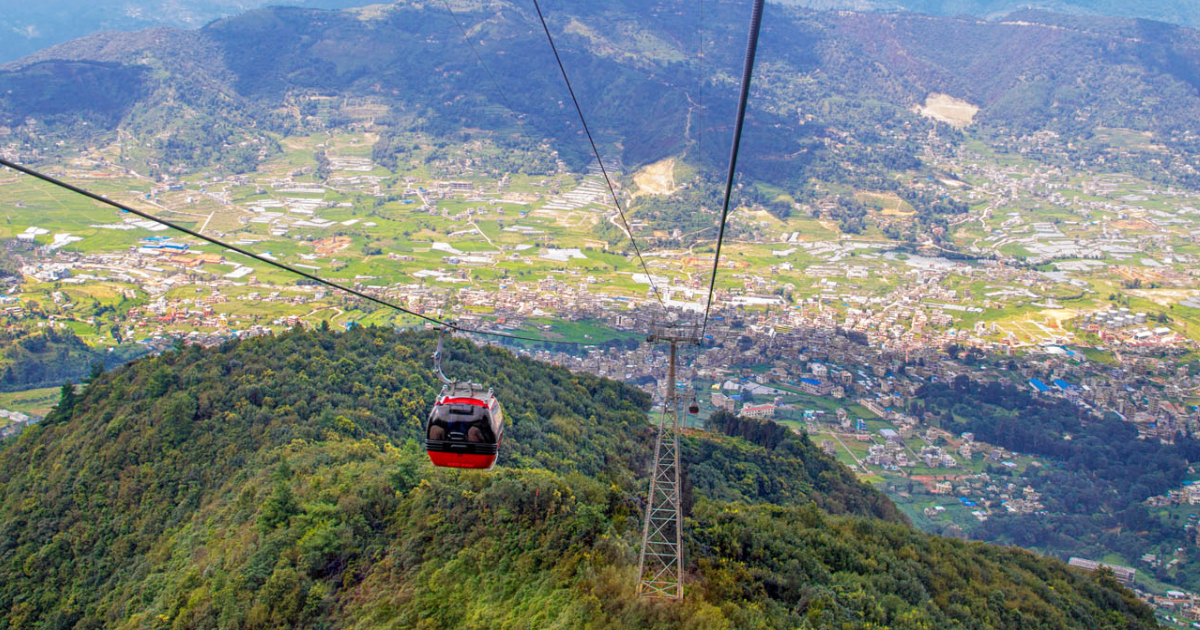
The Chandragiri hill is important to the Nepalese due to its historical and religious significance. According to belief, King Prithvi Narayan Shah chose Kathmandu as the capital of a united Nepal at this very site. Additionally, it is believed that the forehead of Sati Devi, the first consort of Lord Shiva, fell on the hill while he angrily carried her lifeless body. Visitors have the opportunity to enjoy a cable car ride at any time of the year, although the months from September to February are considered ideal. The Bhaleshwor temple, situated at the hilltop, is a major attraction for Hindus. This temple is constructed on the exact spot where Sati Devi's forehead fell.
Tickets Rate of Chandragiri Cable Car
| Tickets Types | Nepalese | SAARC | Chinese | Foreign |
|---|---|---|---|---|
| One-Way | Rs. 475 | Rs. 760 | $ 9 | $ 13 |
| Two-Way | Rs. 799 | Rs. 1280 | $ 15 | $ 22 |
Discount Policy
- Children Up to 3 ft. Free Entry
- Children 3 FT - 4 ft. 40% OFF
- Differently abled Person 50% OFF
- Elderly (Over 60 Years) 25% OFF
- Elderly (Over 80 Years) Free Entry
- Students 25% OFF
- Locals 25% OFF
- Expats 25% OFF
3. Kalinchowk Cable Car
The Kalinchok cable car started operating in 2018. It was established to provide access to Kalinchok, a famous religious site in the Dolakha district. The cable car spans a distance of 900 meters from Kuri in Dolakha to Kalinchok. Kalinchok temple sits at an elevation of 3842 meters above sea level and falls within Kalinchok Rural Municipality of Dolakha. To attract more tourists to Kalinchok, which holds religious and natural importance, a cable car has been put into operation. Devotees find the Kalinchok cable car appealing as it offers an easy, fast, and unique experience to reach the temple. This location holds significance due to its winter snowfall, natural beauty, and religious importance.
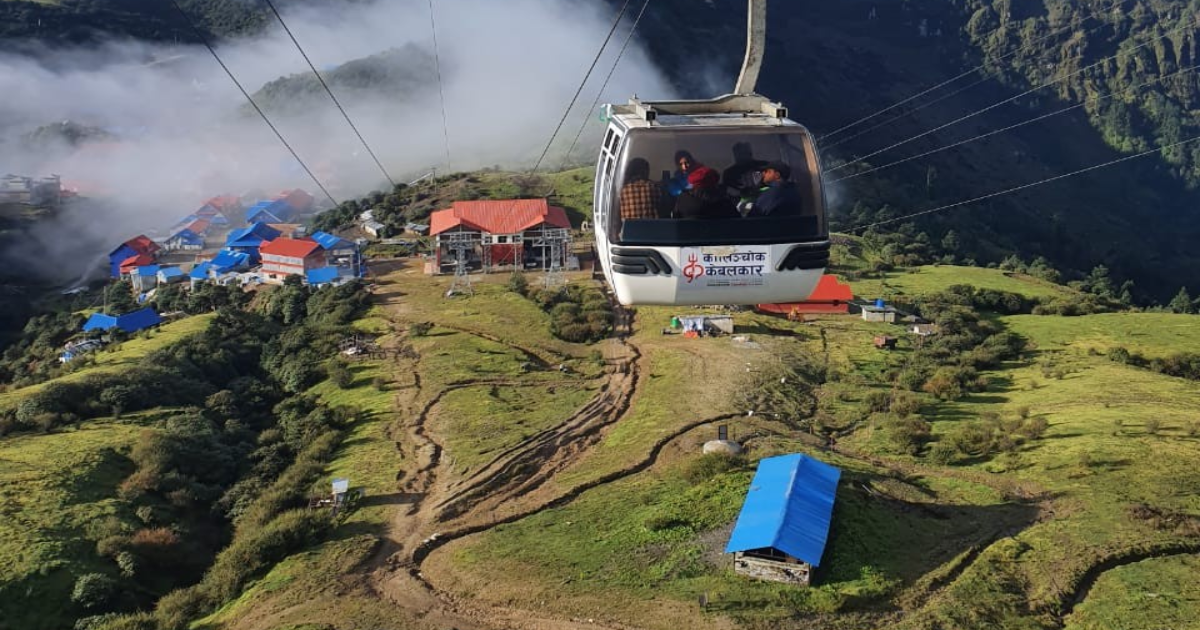
This place is located approximately 17 km away from Charikot (which is the headquarters of Dolakha district). From here, you can see snow ranges such as Jugal, Gourishankar, and Sagarmatha. There are plenty of resorts available in this area. Additionally, you can easily travel to the Cable car station by vehicle. This place attracts tourists not only from Nepal but also from India and China. It is situated 150 km away from Kathmandu.
| Ticket Types | One Way | Two Way |
|---|---|---|
| Regular | Rs. 400 | Rs. 600 |
| Students | - | Rs. 500 |
| Senior | - | Rs. 500 |
| Differently Abled | - | Rs. 500 |
| Indian Citizen | Rs. 640 | Rs. 960 |
| Foreigners | Rs. 760 | Rs. 1300 |
| Goat | Rs. 350 | |
| Goods/KG | Rs. 20 |
4. Annapurna Cable Car
The Annapurna Cable Car is a gondola-based lift transportation system situated in Pokhara Municipality Ward no. 18, Sedibagar, Pokhara, Nepal. They established it in 2073 BS with the purpose of operating a cable car from Sedibagar to Sarangkot. The line, which spans 2.2 km, consists of two stations. With a total of 17 gondolas, the cable car system has the capacity to serve 500 people per hour.
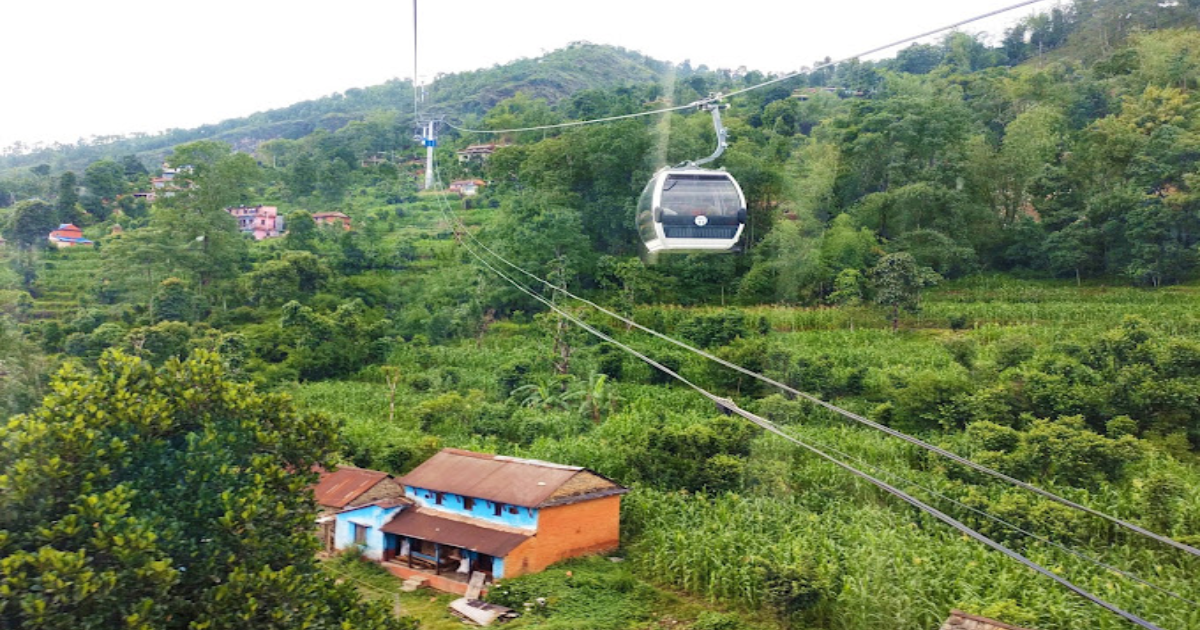
This Cablecar connects Pokhara to the well-known tourist destination, Sarangkot. And, The cable car service is operated by Nippon Cable Co. Ltd. Japan, who have implemented strict safety measures. The Company conduct regular inspections to ensure that the technical and sanitation aspects of the cable car are in order. Moreover, To ensure passenger satisfaction and maintain safe operations, the company employ 80-90 skilled and semi-skilled personnel.
Our mission is to provide an additional tourist attraction for all visitors to Pokhara and its surroundings. Furthermore, We highly value honesty, integrity, safety, good manners, cleanliness, adherence to good health protocols, and displaying a courteous demeanour to everyone.
Ticket Rate of Annapurna Cable Car
| Ticket Types | One Way | Two Way |
|---|---|---|
| Nepal | Rs. 400 | Rs. 700 |
| SAARC | Rs. 500 | Rs. 800 |
| THIRD COUNTRY CITIZEN | $ 5 | $ 9 |
5. Gaidakot - Maulakalika Cablecar
The Gandakot-Maulakali cable car is a new route that is currently operating in Nepal. It has been in operation since Baishakh 2080. And, It stretches from Gandakot in Nawalparasi to the renowned Maulakalika temple. The distance covered by the cable car is 1.2 km. It takes only 5 minutes to travel from the bottom station to the top station. Furthermore, This cable car consists of 12 gondolas for passengers and 2 gondolas for luggage. IME Group is the company responsible for manufacturing this cable car. Additionally, the company is also constructing a 60-room hotel with a helipad in Maulakalika.
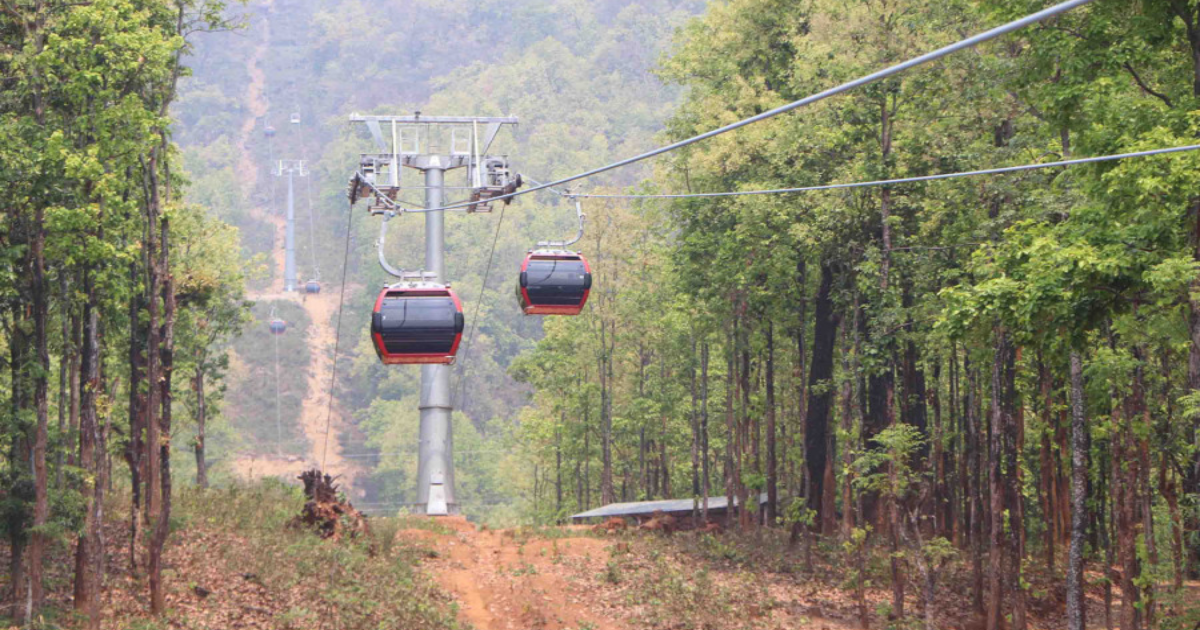
The cable car company has announced that it will offer complimentary service to senior citizens aged 80 and above, as well as children who are below three feet in height.
Maulakalika is a well-known Hindu temple located at an elevation of 561 meters. From this temple, visitors can enjoy views of Chitwan, Madi, and Devghat.
Ticket Rate of Maulakalika Cablecar
| Ticket Types | Two way Rate |
|---|---|
| Per Person | Rs. 550 |
| Children ( 3 to 4 Feet) | Rs. 330 |
| Students | Rs. 415 |
| Senior Citizen | Rs. 415 |
| Differently abled | Rs. 275 |
6. Lumbini Cable Car
The IME Group constructed the Lumbini Cable Car, which has been operating since June 2023. Moreover, This cable car is the first of its kind in the Lumbini region. And, this connects Basantpur in Palpa to Butwal. Furthermore, This spans a distance of 2.6 km. Kamakhya Devi Temple, Bhagwati Temple, Ganesha Temple, and Kailash Mountain serve as prominent attractions in this area. A cable car has been constructed to transform this place into a religious and tourist hub. The cable car's main allure lies in its ability to transport passengers from the plains to the hills, showcasing the region's diverse geography. Moreover, the Lumbini cable car aims to cater specifically to Indian tourists.
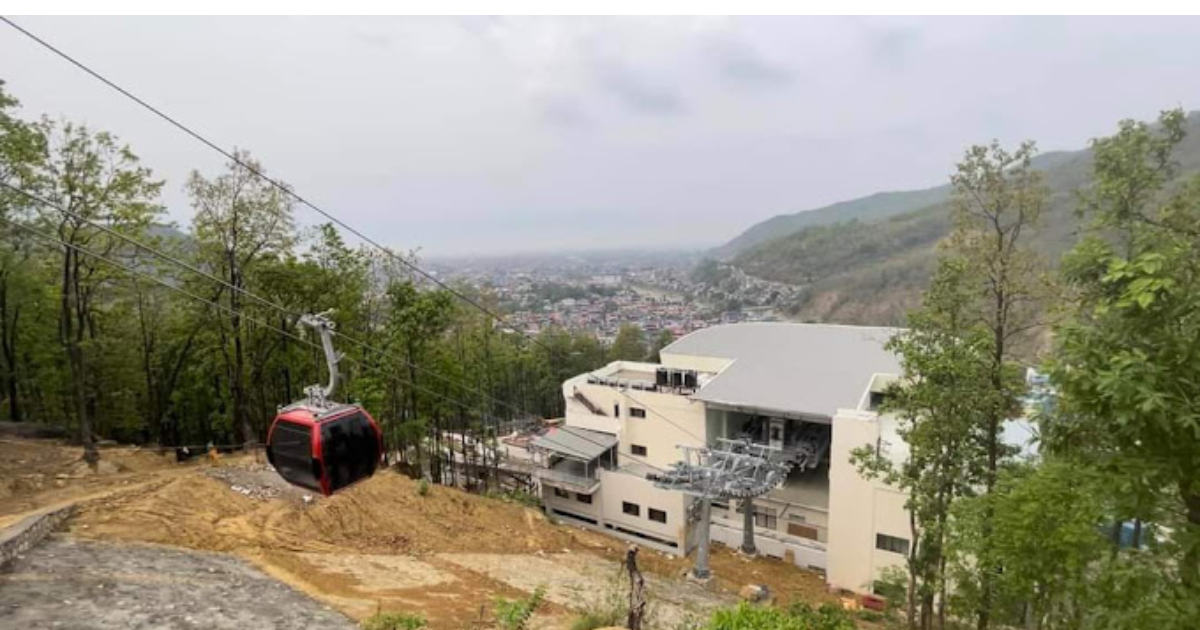
Additionally, The cable car manufacturing company has planned to build a facility-rich resort, park, and other physical structures in this area.
Up-Coming Cable Car Project in Nepal
Lately in Nepal, cable cars are being built at various hill stations. And many companies are planning to build cable car projects. Various companies have taken permission from Nepal government to operate cable cars. In this article, we will present about the cable car project, its length and total investment, which is going to be built and operated in Nepal in the future.
| Cable Car | Places | Length | Condition | Total Investment (With Resort) |
|---|---|---|---|---|
| Bandipur | Dumre - Bandipur | 1.7 KM | Experiment | 3 Arab |
| Siddhatha | Butwal - Nuwakot (Palpa) | 1.94 KM | Under Construction | 1 Arab |
| Pathibhara | Pathibhara - Taplejung | 2.5 KM | Planning | 3 Arab |
| Jalpadevi | Lamkichuhwa (Kailali) - Mohanyal | 3.1 KM | Planning | 5 Arab |
| Sikles | Madi Rral Municipality (Kaski) | 6.4 KM | Planning | 8 Arab |
| Chhimkeswor | Chhimkeswor Temple (Tanahu) | 3.6 KM | Planning | 5 Arab |
| Champadevi | Chalnakhel - Champadevi | 2 KM | Planning | 6 Arab |
| Pokhara -Muktunath | Pokhara - Parwat - Myagdi - Mustang | 86 KM | Planning | 50 Arab |
People expect that cable car in Nepal will soon become an affordable and convenient mode of transportation. Currently, the cable car holds significant importance in the geography of Nepal, not only as a tourist attraction. When trains cannot operate in mountainous regions, the cable car serves as an alternative transportation option. It is definite that the cable car will gain more prominence in Nepal. Considering the present situation, the future of cable cars in Nepal appears promising.
